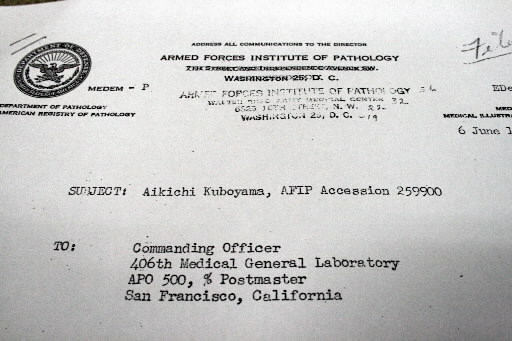Tissue specimens of Aikichi Kuboyama show signs of deterioration
Mar. 4, 2009
by Uzaemonnaotsuka Tokai, Staff Writer
Hideshi Kawakami, director of the International Radiation Information Center at Hiroshima University’s Research Institute for Radiation Biology and Medicine, held a press conference on February 27. The institute has been holding tissue specimens, believed to be from Aikichi Kuboyama, the radio operator of the fishing boat Daigo Fukuryu Maru (Lucky Dragon No. 5), who died at the age of 40 after being exposed to a hydrogen bomb test in 1954. At the press conference, Mr. Kawakami explained the background of the specimens, saying that they had not been properly labeled. They were identified as “A-BOMB” instead of “H-BOMB” specimens and lacked a name.
According to Mr. Kawakami, a set of specimens registered with the number “259900” was among 4552 specimens from A-bomb sufferers that were delivered from the U.S. Armed Forces Institute of Pathology (AFIP) in 1969 and 1970. Unlike other specimens, to which were attached such information as the name of the person, a data sheet, and autopsy record, the specimens from Mr. Kuboyama did not include this material. Also, as the registration number for these specimens is of a different kind from other specimens, researchers at the institute had assumed the labeling was incorrect. Only one piece of paper, with the tag “A-BOMB,” was found with the specimens.
The United States contended that the cause of Mr. Kuboyama’s death was “hepatitis due to a blood transfusion” rather than radiation exposure. Although expectations run high that the pathological specimens can reveal the truth, the five pieces of 1-cm-square tissue have deteriorated and their color has become brownish. Mr. Kawakami added that the institute has no idea which parts of the body these specimens were from, though he noted that tissue samples on 35 prepared slides, found with the specimens, are unlikely from the liver.
With current technology, identifying the cause of death is a difficult task. Mr. Kawakami pledged to preserve the specimens well, saying, “The institute will take special care of the specimens until progress is made in the technology that can analyze them.”
It is believed that the tissue specimens of Mr. Kuboyama were returned to Japan after being provided to the AFIP by a U.S. army doctor who was present at the autopsy. Hiroko Takahashi, a research associate at Hiroshima City University’s Hiroshima Peace Institute, discovered Mr. Kuboyama’s name and the number “259900” in a document she came across in the United States. “The specimens are of significant value as they point to the real condition of radiation sufferers,” Ms. Takahashi said. “I hope they will help clarify the truth.”
(Originally published on February 28, 2009)
Related articles
Hiroshima Univ. holds pathological specimens of Fukuryu Maru crewman (March 1, 2009)
U.S. sought tissue from dead fisherman after 1954 H-bomb test (Feb. 25, 2009)
The hidden truth of the Bikini Incident (March 7, 2008)
Hideshi Kawakami, director of the International Radiation Information Center at Hiroshima University’s Research Institute for Radiation Biology and Medicine, held a press conference on February 27. The institute has been holding tissue specimens, believed to be from Aikichi Kuboyama, the radio operator of the fishing boat Daigo Fukuryu Maru (Lucky Dragon No. 5), who died at the age of 40 after being exposed to a hydrogen bomb test in 1954. At the press conference, Mr. Kawakami explained the background of the specimens, saying that they had not been properly labeled. They were identified as “A-BOMB” instead of “H-BOMB” specimens and lacked a name.
According to Mr. Kawakami, a set of specimens registered with the number “259900” was among 4552 specimens from A-bomb sufferers that were delivered from the U.S. Armed Forces Institute of Pathology (AFIP) in 1969 and 1970. Unlike other specimens, to which were attached such information as the name of the person, a data sheet, and autopsy record, the specimens from Mr. Kuboyama did not include this material. Also, as the registration number for these specimens is of a different kind from other specimens, researchers at the institute had assumed the labeling was incorrect. Only one piece of paper, with the tag “A-BOMB,” was found with the specimens.
The United States contended that the cause of Mr. Kuboyama’s death was “hepatitis due to a blood transfusion” rather than radiation exposure. Although expectations run high that the pathological specimens can reveal the truth, the five pieces of 1-cm-square tissue have deteriorated and their color has become brownish. Mr. Kawakami added that the institute has no idea which parts of the body these specimens were from, though he noted that tissue samples on 35 prepared slides, found with the specimens, are unlikely from the liver.
With current technology, identifying the cause of death is a difficult task. Mr. Kawakami pledged to preserve the specimens well, saying, “The institute will take special care of the specimens until progress is made in the technology that can analyze them.”
It is believed that the tissue specimens of Mr. Kuboyama were returned to Japan after being provided to the AFIP by a U.S. army doctor who was present at the autopsy. Hiroko Takahashi, a research associate at Hiroshima City University’s Hiroshima Peace Institute, discovered Mr. Kuboyama’s name and the number “259900” in a document she came across in the United States. “The specimens are of significant value as they point to the real condition of radiation sufferers,” Ms. Takahashi said. “I hope they will help clarify the truth.”
(Originally published on February 28, 2009)
Related articles
Hiroshima Univ. holds pathological specimens of Fukuryu Maru crewman (March 1, 2009)
U.S. sought tissue from dead fisherman after 1954 H-bomb test (Feb. 25, 2009)
The hidden truth of the Bikini Incident (March 7, 2008)








